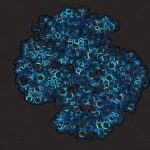Link to Pubmed [PMID] – 20693326
J. Bacteriol. 2010 Oct;192(19):5181-91
The signal transduction ATPases with numerous domains (STAND) are sophisticated signaling proteins that are related to AAA+ proteins and control various biological processes, including apoptosis, gene expression, and innate immunity. They function as tightly regulated switches, with the off and on positions corresponding to an ADP-bound, monomeric form and an ATP-bound, multimeric form, respectively. Protein activation is triggered by inducer binding to the sensor domain. ATP hydrolysis by the nucleotide-binding oligomerization domain (NOD) ensures the generation of the ADP-bound form. Here, we use MalT, an Escherichia coli transcription activator, as a model system to identify STAND conserved motifs involved in ATP hydrolysis besides the catalytic acidic residue. Alanine substitution of the conserved polar residue (H131) that is located two residues downstream from the catalytic residue (D129) blocks ATP hydrolysis and traps MalT in an active, ATP-bound, multimeric form. This polar residue is also conserved in AAA+. Based on AAA+ X-ray structures, we proposed that it is responsible for the proper positioning of the catalytic and the sensor I residues for the hydrolytic attack. Alanine substitution of the putative STAND sensor I (R160) abolished MalT activity. Substitutions of R171 impaired both ATP hydrolysis and multimerization, which is consistent with an arginine finger function and provides further evidence that ATP hydrolysis is primarily catalyzed by MalT multimers.

